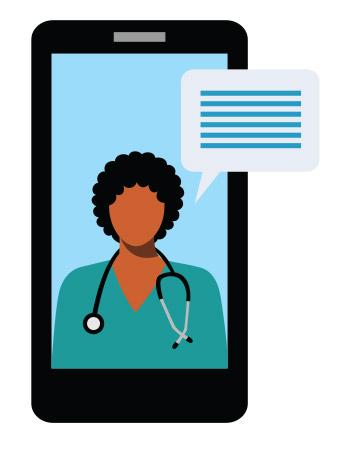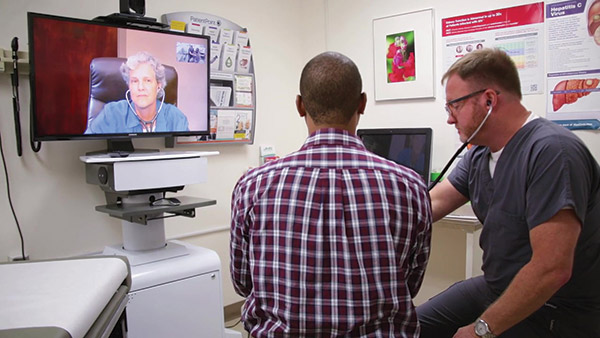
For years, telehealth was an emerging technology that couldn’t quite deliver. It promised to bring patients and health care providers closer together through smartphones, high-speed internet access, and video conferencing. But it was always held back for one reason or another.
And then, the COVID-19 pandemic—with its social distancing and sheltering at home—hit. Telehealth became just what the doctor ordered.
Sometimes called “telemedicine,” telehealth is a broad term that covers how individuals and their care providers use communications technology to share information. It can be as simple as a phone call or text, or as sophisticated as a video conference over your computer, smartphone, or other device. It can refer to medical and mental health care, as well as services such as case management or linkage to care. While the two seem interchangeable, most people nowadays are using “telehealth” to describe the entire field.
In March, as states and municipalities issued stay-at-home orders to prevent exposure to and mitigate the spread of COVID-19, health care organizations, doctors’ offices, and hospitals have increasingly made telehealth the everyday delivery method of providing care, especially to those most vulnerable, such as people living with HIV.
Only several months before the pandemic, Rutgers University Hospital had started looking into telehealth.
“Over the last six months, as an HIV clinic, we were looking into telemedicine because we hoped that it could be a very good tool to keep patients in care—people who might otherwise be vulnerable to disengaging in care,” said Michelle DallaPiazza, MD, assistant professor of medicine at the hospital’s infectious diseases division. “Harder to reach patients may be younger and tech savvy, but they may have busy lives or schedules that could make it difficult to come in for an appointment during regular clinic hours.”
The telehealth program was still just getting off the ground when the pandemic hit.
“Like many places, we hadn’t really had a lot of investment from the hospital in telemedicine until the COVID-19 pandemic,” said DallaPiazza. “But now both the medical school and the hospital with which we are associated diligently and rapidly got a telemedicine system up and running to be able to avoid major interruptions in care during the pandemic. We’ve been contacting patients to change their in-person appointments to telehealth visits. For patients who have a smartphone, it’s as simple as tapping on a link sent via text, and they can video chat with their provider. For patients who don’t have a smartphone, we are reaching out to them with a simple phone call.”
This changes everything
If the pandemic forced a change in how medical care is delivered, it has also changed the rules—at least for now—easing some of the restrictions that had held telehealth back.
One of the most significant changes came March 17 when the U.S. Department of Health and Human Services (HHS) Office for Civil Rights announced it was relaxing enforcement of the HIPAA patient privacy rules, essentially allowing clinical visits in most non-public facing audio and video platforms. Most organizations are opting for commercial platforms such as Zoom, which offer at least some measure of security, as opposed to consumer applications such as FaceTime and Skype.
Another major shift was the decision by the U.S. Centers for Medicare & Medicaid Services (CMS) to pay for telehealth services, stating, “with the emergence of the virus causing the disease COVID-19, there is an urgency to expand the use of technology to help people who need routine care, and keep vulnerable beneficiaries with mild symptoms in their homes while maintaining access to the care they need.”
The announcement by CMS removed what had been one of the biggest barriers to telehealth’s expansion.
“There’s been tremendous movement in the past few weeks to change the standards and relax HIPAA privacy requirements and other barriers—some of them temporarily, some of them permanently—so that more telehealth services can be provided,” said Brian Hujdich, executive director of HealthHIV, a national organization that provides education and capacity building for other agencies in the areas of HIV, hepatitis C, and LGBTQ health.
Shaping those standards will be an alphabet of stakeholders—federal agencies such as the CDC, CMS, and HRSA; professional medical associations such as AMA and AACME (Accreditation Council for Continuing Medical Education), weighing in on medical standards; and the FCC, which will help set technical requirements.
“That’s where the nonprofits can engage,” said Hujdich. “As a community, we can make sure that we are letting the decision makers, the policymakers, the funders of the situation. We have to develop telehealth programs that are meaningful and reflective of everyone in the community. We will help inform how these efforts are developed, funded, and implemented.”
In March, HealthHIV announced the launch of a new program aimed at helping community-based organizations and public health departments to develop and expand their own HIV prevention and care telehealth services by providing education and technical assistance.
“There are so many unknowns at this point that the more we keep assessing what’s happening and what’s needed, the more relevant telehealth will be,” said Hujdich. “Depending on how well it is adapted, this could set about some significant and permanent change in how HIV care is delivered.”
Satellite system
Medical Advocacy & Outreach (MAO, formerly Montgomery AIDS Outreach) is the primary care provider for people living with HIV in south Alabama. MAO’s service area encompasses central and southern Alabama—18,675 square miles—some of the poorest counties in the U.S., and a region hard hit by HIV.
“There's no way we can have enough staff to go out there and do what we need to do,” said MAO chief executive officer Michael Murphree, LICSW. “So, telemedicine was the answer for us.”
In 2012, MAO partnered with two other agencies—Thrive Alabama, based in Huntsville and Whatley Health Services in Tuscaloosa—to launch Alabama eHealth, a program providing telehealth services to 50 of Alabama’s 67 counties. HIV-specific care is provided through a network of primary care medical clinics.
Not only is the area poverty-stricken, like many rural areas in the U.S., much of MAO’s service area also lacks high-speed broadband internet access. To overcome this, MAO devised a hub-and-spoke strategy for its delivery system, a network of 11 satellite clinics linked to three hubs tucked in corners of the agency’s service area—in Atmore, Dothan, and Montgomery.
From MAO’s clinic in Montgomery, Alabama, Laurie Dill, MD, AAHIVS (on screen) meets with a patient in Atmore, 120 miles away.
Connecting the network is a telecommunications bridge, an infrastructure that uses a military level of encryption called AES-256 to ensure privacy and security. In areas where broadband internet is available, MAO’s doctors, mental health therapists, and case managers can send an email link to a patient or client who has access to a computer, smartphone, or other device that will allow for a face-to-face video appointment.
More typical, however, is a patient visiting one of the satellite clinics, where a nurse conducts a physical examination using medical equipment such as a wireless Bluetooth-enabled stethoscope. Blood pressure, temperature, and other readings are captured and entered wirelessly into the patient’s medical record in real time. With high definition monitors and high resolution 1080p cameras at either end, Murphree says the patient often forgets they are talking with their doctor via a telehealth link.
But Murphree sees the next step in telehealth as what he calls, “suitcase units,” portable equipment that allows a nurse to conduct the same clinic exam, connecting to a hub-based doctor, but from a patient’s home. Not only would it increase the number of people living with HIV who are receiving care, Murphree says, but it would increase retention rates and improve viral suppression.
Navigating success
Based out of the University of Florida’s hospital, UF Health, in downtown Jacksonville, UF Cares is the largest provider of HIV services in the Jacksonville area. The telehealth program was launched in 2017 by the neurology and family medicine department; it connected a few iPads to the back of rescue units, implementing a program for stroke patients. Survival rates dramatically improved, and soon the program was expanded to include family medicine, training all primary care providers so that they could see patients via telehealth.
UF Cares’ success earned it a grant from the CDC, funding a three-year project starting in September 2018 to adapt the telehealth program for people living with HIV, focusing on care in urban areas.
“There were first-year challenges,” acknowledged Reetu Grewal, MD, UF Health’s medical director of Family Medicine and Pediatrics at the Baymeadows clinic, listing some of the program’s stumbling blocks. “The lack of insurance parity for telemedicine visits was a hindrance. A lack of staff members specifically tasked with certain roles, such as patient enlistment. Many patients were initially concerned about privacy of medical records. Some UF Health medical providers were also reluctant at first. Patients were having to get accustomed to the technology.”
Without a staff member specifically tasked to the project, different telehealth assignments were relegated to various clinic staff, who were already busy with their own workloads. However, that changed in 2019.
“We hired a telemedicine navigator who attends the case management meetings every week,” said Grewal. “We see someone would be a good match for telehealth, and it’s her job to call the patient to see if they would want to enroll. Before, a patient might not get asked or receive a follow-up call. She also goes around the clinic, talking to patients to get them interested in telehealth, answering their questions. She takes people step by step through the process.”
Grewal credits the patient navigator for substantially improving the project’s recruitment and patients’ satisfaction with telehealth. The program is integrated with the clinic’s EPIC electronic medical records system. Patients connect to their telehealth appointment using the streaming video conferencing platform Zoom. However, if a person doesn’t have a smartphone or the technical savvy to get online, they can visit any family medicine clinic throughout the UF Cares network or a number of local community-based organizations, and conduct their telehealth appointment there.
The convenience of telehealth and the personal attention patients receive has been critical to the success of UF Cares’ telehealth program.
“The more that they use it, the more they like it,” said Grewal. “I only see it growing in the future.”
Making the most of an uncertain future
The COVID-19 pandemic has given telehealth the opportunity—if not the necessity—for explosive growth. But it has also forced health care and service organizations down an unfamiliar road.
“We’ll learn from it,” said John Scott, medical director of the telehealth program at the University of Washington, in Seattle. “Given the rapid expansion, it’s not going to be perfect, but we are committed to getting it right and learning from it, and making it available to everyone.”
Established in 2008, the UW program didn’t really begin to grow until 2015, and even then was hampered by the absence of rules allowing for Medicaid reimbursement. But things suddenly changed with the rise of the coronavirus pandemic.
“One of the big challenges has been that we’re not just doubling the number of patients we’re seeing via telemedicine; we’ve gone up 50- to 100-fold because of the pandemic,” said Scott. “The scaling is unprecedented. You have to be strategic about your process and how you manage the growth.”
For organizations new to telehealth, his advice is simplicity.
“You’ve got to make it as simple as possible, both for patients and clinicians,” he said. “Leverage what you have, and use telemedicine to scale it up. To the extent that you can, it’s important to standardize processes, stick with one type of technology, and leverage the relationships you already have with other organizations.
“I think we’re in this for the long haul,” he added. “Any technology that allows us to stay connected while allowing us to maintain social distancing is going to be very empowering. For the most part, telemedicine works. Both patients and providers appreciate what it is doing for care.”
HealthHIV’s Brian Hujdich also sees opportunity in the uncertainty: “There are so many unknowns at this point that the closer we stay to each other, the more we keep assessing what’s happening and what’s needed, the more relevant telehealth will be. Depending on how well it is adapted, this could set about some significant and permanent change in how HIV care is delivered.”
“Out of this pandemic, I believe that this has opened everyone's eyes to the fact that we must do something a little different in order to serve,” said MAO’s Michael Murphree. “All of us can be true advocates and say, let's not forget what happened—let's make sure this doesn't happen again, by preparing to use new ways to deliver confidential and compassionate services.”




